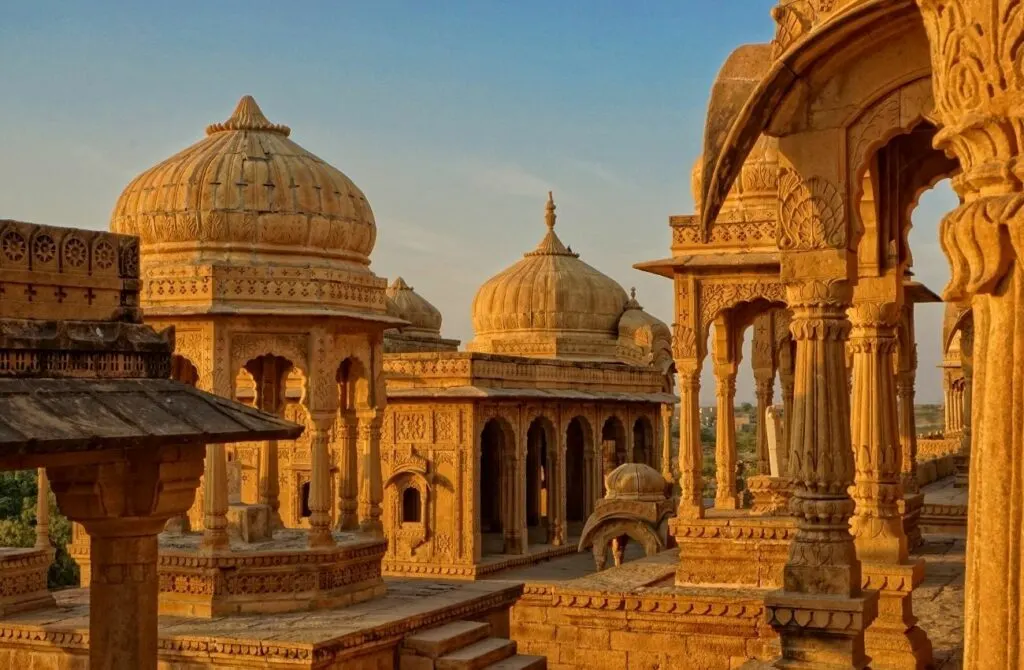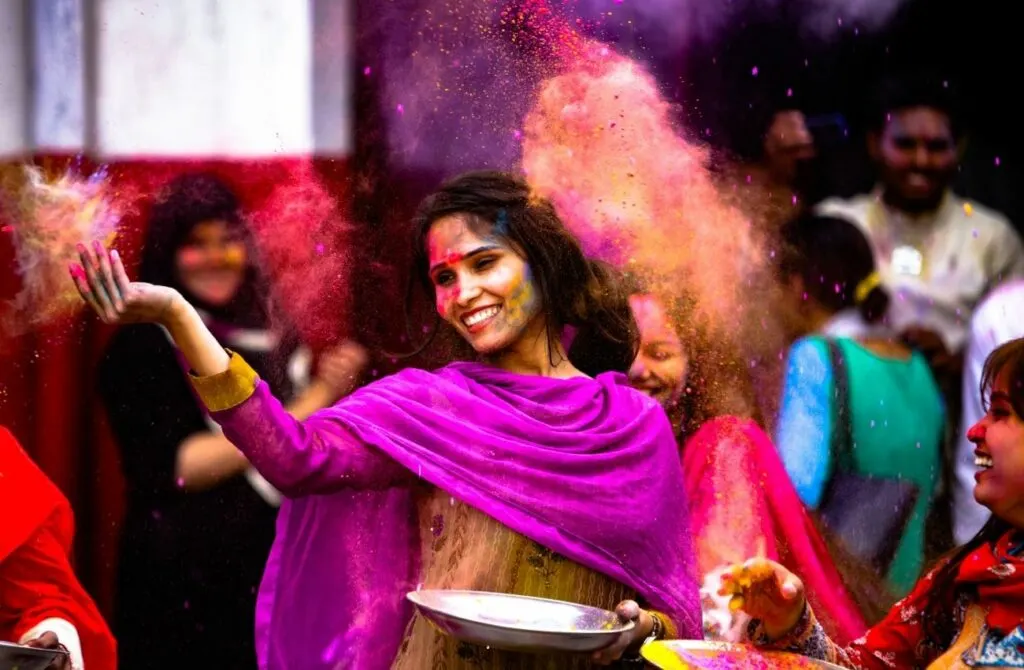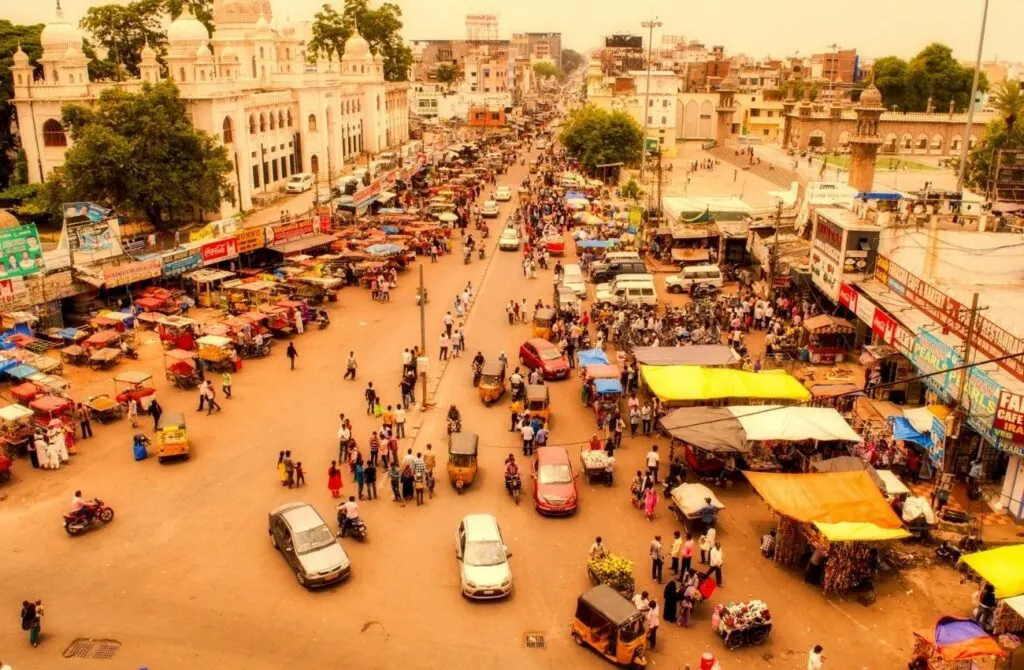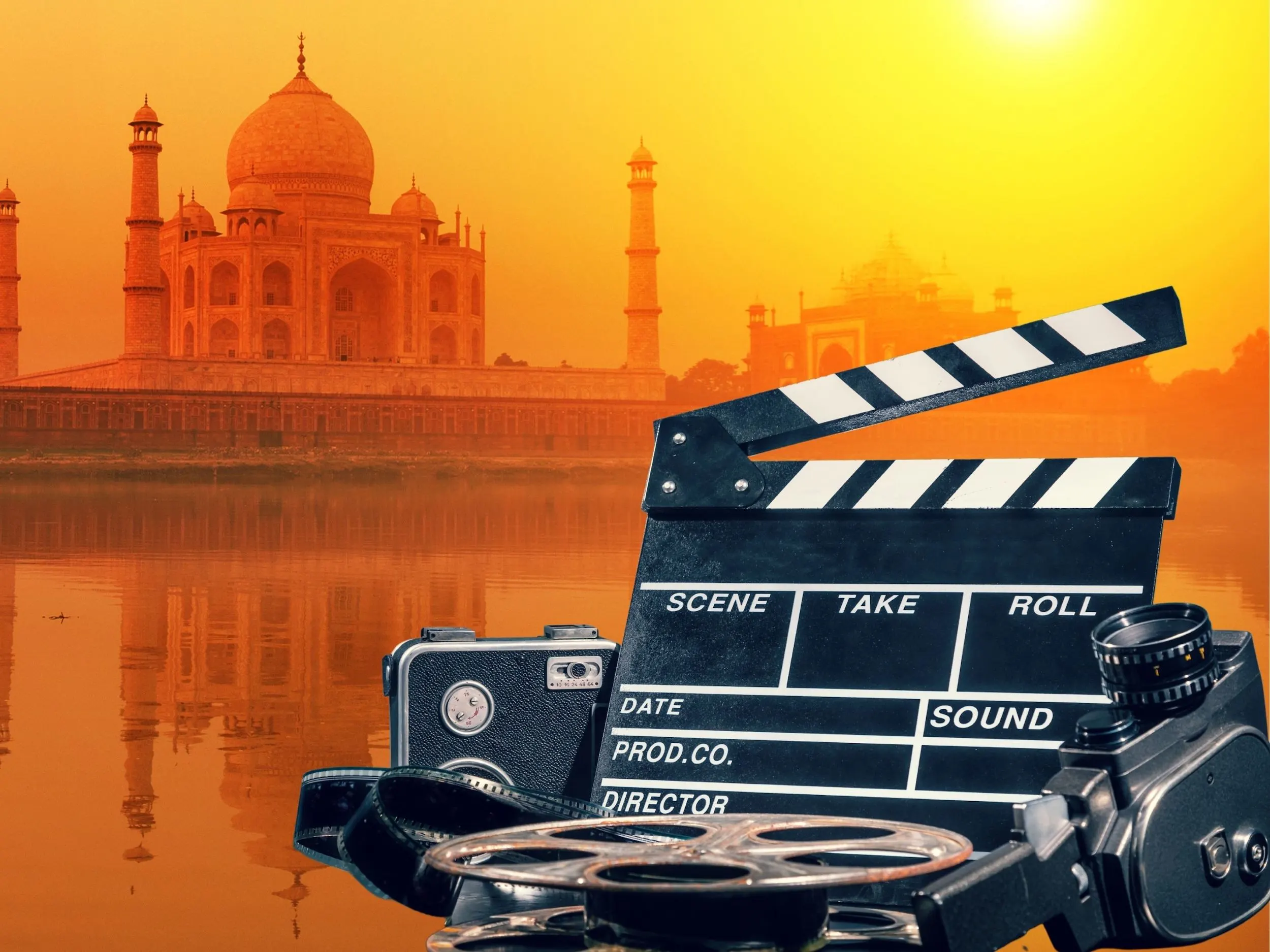Sofia De Vera combines a heartfelt passion for cinema with over 15 years of critiquing for esteemed film publications, wielding academic credentials from the University of Southern California and New York University, to serve as your personal guide through the enchanting worlds of film and television. Her full guest bio can be found here.
India has a lot to offer both national and international filmmakers with exquisite natural and urban landscapes, a rich cultural heritage – and generous film tax credits and incentive programs. So it will come as no surprise that there are so many unforgettable movies set in India.
Watching a good movie is the best way to get inspired and choose your next destination. And it is in honor of the concept of cinematic travel that we have previously assembled various lists of the best films shot in some of our all-time favorite travel destinations: Vietnam, Hong Kong, Amsterdam, Tokyo, Mexico City, Poland, and Finland. And now, we have added Vietnam to this list!
There are things that a photo alone can’t capture. We are human, and we need movement: the waves crashing against a sandy beach, the sun setting against a quiet temple, people walking side by side through a bustling urban environment. These are things that are better experienced with movement. These are things that belong in movies. And these things are India.

For a long time, foreign and native directors have captured on film some of the country’s most stunning sights and landmarks. The local Indian cinema industry might not be well-known in the West, but it is certainly full of life. It even overtook the U.S. film industry to become the largest center for film production in the world back in 2001.
Within Bollywood (as the Indian Hindi-language film industry based in Mumba is affectionately known), directors bring to the screen daring stories set in one of the most unique places in the country, full of old wonders and some of the most diverse people in the world.
But if there’s something that defines India, it’s its colors. The pink Jaipur, the blue Jodhpur, the orange Ranthambore Tiger Reserve, and the white Udaipur. India is full of cities that spark like a rainbow, like Hyderabad. And then there are the numerous UNESCO World Heritage Sites…
The country seems to be made for filming—the beautiful Rishikesh at the foot of the Himalayas or quiet Varanasi by the Ganges River. More and more people from all over the world are watching Indian cinema, with films that cater to all tastes, such as Bollywood productions or indie pieces. It’s a place that artists are drawn to. People from all over the world have tried to capture its beauty. Luckily for us, there are several must-watch films that achieved just that.
The films in this list of movies set in India paint a picture of a complex country filled with gorgeous sights and diverse voices. With this, we hope to help audiences step into the often-contradictory world of India and experience the scenery, subcultures, and different dynamics that make India what it is today.
These Indian films frequently boast narratives that rely on their settings as much as their main protagonists, and as a result, spectators get a glimpse of India through the director’s eyes. Be forewarned that not all of these films are happy – tragedies and misery are as unavoidable in cinema as they are in life – be we promise that each one provides panoramic vistas and thought-provoking narratives from this tantalizing country…and have you looking up the best Indian tour companies before the final credits roll.
Wondering where to watch? It depends on where you live in the world and which streaming services you have. We link to the streaming service we watch on in each case - be it Netflix, Amazon Prime, Apple TV+, or elsewhere.
You can get one month free of Amazon Prime (or a 6-month trial for students) of Amazon Prime and also get immediate access to FREE Two Day shipping, Amazon Video, and Music. While you won't be charged for your free trial, you'll be upgraded to a paid membership plan automatically at the end of the trial period - though if you have already binged all these, you could just cancel before the trial ends.
Apple TV+ also has a one-week trial, and Hulu has a one-month trial (which can be bundled with Disney!). Another option might be using a VPN to access Netflix titles locked to other regions. Netflix is now available in more than 190 countries worldwide and each country has a different library and availability. US Netflix is (understandably) one of the best.
While we wish everything could just be in one place - for now, it seems these are the best streaming platforms to watch on.



Page Contents
The Best Exotic Marigold Hotel (2011)
The Best Exotic Marigold Hotel (2011), by John Madden, tells the story of five pensioners who leave their native Great Britain to spend the rest of their days in a luxurious retirement hotel in India. But when they arrive, they find out that the hotel is not what it seems. The movie features an ensemble cast of British stars: Judi Dench, Bill Nighy, Penelope Wilton, Tom Wilkinson, Celia Imrie, Dev Patel, and Academy Award winner Maggie Smith.
Ravla Khempur, the hotel where the movie was filmed, was built in the 17th century as a haveli. These manors are a staple of Indian architecture. As seen in the film, havelis are ample palaces made out of ornately decorated wood and stone. They usually have big courtyards in the center and are designed so that cool air moves through the house. Following the success of the movie, the hotel’s name was changed to “The Best Exotic Marigold Hotel.” Now it functions both as a hotel and as a horse sanctuary.
The Best Exotic Marigold Hotel is set in stunning Udaipur. Known as the “City of Lakes,” it was founded in 1559, during the Rajput era. Its many palaces, manors, and temples stand in the midst of seven crystalline lakes. Boat rides through these lakes allow one to see the city in an astounding new way. It’s no surprise that this eastern Venice has been called “the most romantic spot on the continent of India.”
The Dajeerling Limited (2007)
The Dajeerling Limited (2007) was directed by acclaimed auteur Wes Anderson. It tells the story of three brothers (Owen Wilson, Adrien Brody, and Jason Schwartzman) who go on a “spiritual journey” through India one year after the death of their father. Anderson is known for his unique narrative style: the movie is a mix of happiness and sadness, paired beautifully, thanks to its colorful visuals.
This is a great movie to watch if you love to travel by train. For Anderson, trains are full of life and color. He portrays them as a place where people get to know each other while visiting life-changing locations. While the titular luxury train “The Darjeeling Limited” is not real, there are several rides like it in India. The Palace on Wheels, for one, takes you through the state of Rajasthan, where most of the movie was filmed. There’s also the Darjeeling Himalayan Railway, whose journey ends in the high city of Darjeeling. Just like in the film.
The movie also shows one of India’s most striking cities, Jodhpur. This metropolis is known as the “Blue City,” as most of its houses are painted in different shades of blue. The city sprouted around the Mehrangarh Fort, a sturdy construction built in 1459 over a hilltop. When Adrien Brody’s character stands by the fort, we can see the amazing sight of the sun setting over the expansive blue buildings.
A Passage To India (1984)
A Passage to India (1984) was the last film by prestigious director David Lean. This epic historical drama is set during the rule of the British Crown in India in the 1920s and is based on a novel of the same name by E. M. Forster. It was critically praised and was nominated for eleven Academy Awards and won two of them (Best Score and Best Supporting Actress).
The story follows Adela Quested (Judy Davis) as she leaves Great Britain to marry the magistrate of the fictional Indian city of Chandrapore. As she arrives there, she finds a deep rift between the British and the Indians. When she meets Dr. Aziz (Victor Banerjee), even her own prejudices about the natives are tested. The film depicts the rise of the Indian independence movement that resulted in the end of Great Britain’s rule in India in 1947.
The pivotal scene in A Passage to India happens during an expedition to the Barabar Caves (called Marabar in the movie). This set of rock-cut caves is believed to be the oldest in the country. The people of the Maurya Empire carved into the hill wall and made these chambers sometime around 250 B.C., the most famous of them being the Lomas Rishi Cave. Its entrance bears the earliest known chandrashala, rich rock carvings that embellish the entrance of Indian temples.
Monsoon Wedding (2001)
Monsoon Wedding (2001), by Mira Nair, is a comedy and drama film set entirely in New Delhi during a wedding of the Punjabi Hindu tradition.
In Indian culture, weddings are big events, particularly those that take place during monsoon season, when the whole extended family comes to visit. As the date of the arranged marriage between Aditi (Vsundhara Das) and Hermant Rai (Parvin Dabas) comes closer, all kinds of family drama begin to take place. The kind that can end a wedding prematurely. This lauded film was dubbed “the best romance of the 21st century” by the film website IndieWire.
The film does a great job of depicting the festivities that take place in India during the monsoon season. Both West Africa and Asia are known for these seasonal periods of heavy rains and high humidity. Since monsoon seasons happen after long dry periods, their arrival allows the growth of new plants and the flourishing of crops. Naturally, this is cause for celebration. June is the month when you will want to visit India to take part in the fun.
It’s a great movie to watch if you want to know what a vivaah, an Indian wedding, looks like. They are enormous events that last several days. Attendants dress with colorful attires, sometimes laced with gold jewelry. The woman, in particular, wear stunning colors and adorn their skin with henna tattoos. Monsoon Wedding illustrates the rituals involved in a wedding, the gifting of the daughter, the ceremony of steps that the bride and groom undertake, and the vow of Saptapadi that bind them together.
But, in the end, it also shows a simpler wedding, one where the focus is on the love of the couple.
Monsoon (2014)
Monsoon (2014), by Sturla Gunnarsson, is a documentary about the Indian monsoon weather system. It shows the many, many individuals whose lives are completely changed when the seasonal deluge arrives. The director follows the storm that begins in the south of the Malabar Coast all the way up to the town of Cherrapunji, “the wettest place on earth,” located on the other side of the country.
The film lets us experience the beauty of the monsoon. The rains bring life. Plants and crops grow. Farmers and rejoice. Children of the slums play under the falling water. But it doesn’t shy away from the chaos of the storm: the rains break damns and floods entire villages. Even in the biggest monsoon, not all of India is blessed by the rain.
The film presents a stunningly real depiction of India. Monsoon captivates you. Its beautiful documentation of this epic event is something you need to see to believe.
Gandhi (1982)
Gandhi (1982), directed by Richard Attenborough, is a biographical film retelling the life of Mahatma Gandhi. The movie garnered a lot of interest upon its release: even though it was only shown in a few theaters, thousands of people watched it in its first week out. Today it’s still one of the highest-grossing movies in India. It was internationally well-received, having won eight Academy Awards (including Best Actor, Best Director, and Best Picture).
This is a great movie to watch if you are interested in the influential figure that was Gandhi. The movie shows his whole life, starting with an incident in South Africa in 1893, when he was twenty-three: the authorities of the train he was traveling in had him kicked out of first-class, even though he had a ticket. In the night he spent alone in the train station, Gandhi decided to start his first non-violent protest campaign.
It is also a must-watch for anyone interested in the history of India and its independence. The film follows Gandhi as he travels back to his homeland, in 1915, with the intention of campaigning for India’s independence from British rule. This goal was achieved while he, now a congressman, was held prisoner by the British State. But Gandhi disapproved: the independence brought a partition between India and Pakistan due to the latter being a Muslim state. He was killed a year later by a Hindu nationalist.
Today there are five Gandhi museums (known as Sanghralayas) where one can learn more about his life and work.
Asoka (2001)
Asoka [Aśoka] (2001), by Santosh Sivan, is a historical epic about the life of the Mauryan Emperor Asoka, ruler of India, from 268 to 232 B.C. Even though it was recorded completely in Hindi (the language spoken in North and Central India), lots of American and British moviegoers watched it. It was praised for its daring narrative and extravagant music, with some reviewers comparing it to Braveheart.
This film begins with a young Asoka claiming the sword of his recently retired grandfather. He says that the sword is evil, but Asoka doesn’t believe him. The politics of the palace lead an older Asoka (Shah Rukh Khan) to escape the life of a prince and travel the country. He finds love with Kaurwaki (Kareena Kapoor) and lives a life of anonymity. But soon, the duties of princedom call him back to the palace, risking the new life he found.
Asoka shows some great sights of old India. The huge armies are decked out with Mauryan armor, the war elephants standing next to the men. The wide expanse of green mountains where Asoka lives Kaurwaki, was filmed in misty Hoshangabad. The richly dressed men and women of the palace, their foreheads marked with tilakas. This movie is a great watch for anyone interested in ancient India and its legends.
Bajirao Mastani (2015)
Bajirao Mastani (2015), by Sanjay Leela Bashanli, is a historical epic about the romance of Bajirao I, the Prime Minister of the Maratha Empire, and Mastani, his second wife. It’s one of the highest-grossing films in India. It also won several Indian awards for its direction and for the acting of the main cast.
During the beginning of the 18th century, the Emperor of Maratha (who ruled most of India at the time) elected a new Peshwa, a role akin to a prime minister. After a trial of skill with the bow, young Bajirao (Ranveer Singh) becomes Peshwa. Bajirao marries Kashibal (Priyanka Chopra) and fights for his emperor for several years.
During his years as a warrior, he meets Mastani (Deepika Padukone), the daughter of a Rajput king and his consort, and recruits her into his army. They fall in love while defeating an invading army. But sooner or later, Bajirao must return to the palace and to his wife.
Like Asoka before, Bajirao Mastani it’s a great look at the historical legends of India. The sets and costumes in this movie are wonderfully crafted, clear proof that the quality of Indian cinema it’s still getting better. However, the most beautiful shots in the movie are those filmed in the Amber Fort in Rajasthan. The sandstone fort next to Maota Lake can be seen in all its glory during some of the palace scenes in the movie.
A Pure Desi Romance (2013)
A Pure Desi Romance [Shuddh Desi Romance] (2013) is a romantic comedy directed by Maneesh Sharma. It stars Parineeti Chopra as Raghu, a young tourist guide bound to an arranged marriage, and Sushant Singh Rajput as Gayatri, an independent woman who impresses him with her freedom. They fall in love and have to deal with the pressures of being a young couple in India.
The movie depicts a modern view of Indian traditions regarding relationships. It touches on subjects that traditional people don’t like to talk about, like live-in relationships and fear of commitment. The ending of the movie shows Raghu and Gayatri finding a new way to live their relationship. One is beyond what others want for them but closer to what they want for themselves.
A Pure Desi Romance is set in stunning Jaipur, a great city for romance. Known as the “Pink City,” Jaipur has a variety of aesthetically pleasing palaces and temples, all of them in the midst of hundreds of pink houses. Since Raghu is a tour guide in the city, we see several of the nicest tourist attractions in the city, like the Jal Mahal or the Hawa Mahal.
Chennai Express (2013)
Chennai Express (2013), by Rohit Shetty, is an action-comedy. It tells the story of Rahul (Shah Rukh Khan), a bachelor in his forties that mistakenly boards the Chennai Express due to the city of Rameswaram. On the train, he meets a mysterious girl (Deepika Padukone), who turns out to be a mobster’s daughter. Khan and Padukone were, at the time, two of the most famous Bollywood stars.
Chennai Express lets us see one of the most impressive cities in India. Rameswaram is located on an island only connected by a railway bridge to mainland India. It’s one of the holiest places in the country, housing one of the Dhams that are part of the Char Dham pilgrimage.
The most beautiful sight in the city is the Ramanathaswamy Temple, built for the adoration of the god Shiva. Several of the major Hindu traditions consider it a site of holy pilgrimage. The main characteristic of the temple is its huge, layered towers known as gopurams, which are richly carved out of white stone. If you plan to visit India, you owe it to yourself to visit this astounding place.
Beloved One (2013)
Beloved One [Raanjhanaa] (2013), by Aanand L. Rai, is a romantic drama film set in Varanasi. It tells the story of two young would-be lovers who are divided by religion: Kundan (played by Danush) is Hindu and Zoya (Sonam Kapor) is an orthodox Muslim. She is sent to a university in Dehli, but eight years later, they meet again.
The movie is set in the ancient city of Varanasi, also known as Banaras. Kundan and Zoya eat the traditional street food of the city, they stroll together under its Mughal-era buildings, and they kiss by the Ganges River. During most part of their romance, the city is only a backdrop.
But when the Holi festival arrives, the city takes center stage. One of the most moving scenes of the movie happens during the “Festival of Love.” To celebrate the love of Radha Krisha and the arrival of spring, a series of Indian rituals culminate in an explosion of colors: everyone throws colored powders to each other, and then they share traditional Holi drinks.
The Lunchbox (2013)
The Lunchbox (2013) was the first film directed by Ritesh Batra. It’s an endearing romance told in an epistolary fashion.
It stars Nimrat Kaur as a young wife who, trying to connect more with her husband, sends him a lunchbox to his job. However, the person who receives the box is a lonely widower, played by Irrfan Khan. He returns the lunchbox, and, as thanks, she sends another one with a note attached. They exchange messages back and forth only through the lunch boxes, and their friendship soon evolves into something else.
The movie depicts a central part of the culture in big Indian cities: the dabbawalas. Due to the sheer amount of people who live and work in metropolises like New Dehli or Mumbai (where the movie is set), getting warm food for lunch becomes a problem. People in India work lots of hours and don’t have the time to go out to eat in the street.
That’s where the dabbawalas come in. Established around the end of the 19th century, this system allows for lunchboxes to be delivered from homes or restaurants to workplaces, and then returned back. Their name literally translates to “one who carries a box.”
The scenes in the movie featuring the dabbawalas were shot like a documentary. A limited filming crew of four members followed these workers through the day and recorded what they did. It shows them as something more than delivery drivers. They are a large but close-knit organization since most of them belong to the same branch of Hinduism. But they also are the cornerstone of the businesses operating in the big cities of India.
Slumdog Millionaire (2008)
Slumdog Millionaire (2008), by Danny Boyle, is arguably the best-known and most celebrated movies set in India. While Boyle had been a well-known director, this movie cemented him as one of the best. This sad yet empowering drama won eight Academy Awards, most notably Best Director, Best Picture, and Best Adapted Screenplay.
It shows the life of Jamal (Dev Patel), a young contestant in an Indian version of Who Wants to Be a Millionaire. Due to his unassuming demeanor, he surprises the whole country as he answers every question correctly. The corrupt Indian police suspect he is cheating, so they capture and question him. He then tells the story of his life: from his life in the slums of Mumbai, to his attempt to make money in the Taj Mahal while being only a child. A series of tragic circumstances led to him being able to know the answers to the questions he was asked.
Slumdog Millionaire is a must-watch movie. It portrays the ugliest parts of India. But even in the most tragic scenes, love and courage still shine through. Jamal never loses hope. This movie is about taking the worst situations and turning them into something else, something useful, something good. After the trials and tribulations of the film, the ending is a well-deserved moment of happiness and joy.


